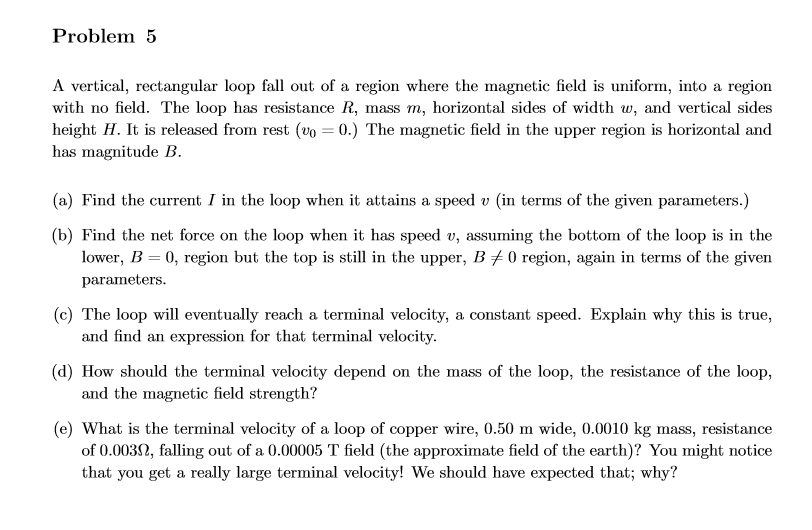Problem 5 A vertical, rectangular loop fall out of a region where the magnetic field is uniform, into a region with no field. The loop has resistance R, mass m, horizontal sides of width w, and vertical sides height H. It is released from rest (vo = 0.) The magnetic field in the upper region is horizontal and has magnitude B (a) Find the current I in the loop when it attains a speed v (in terms of the given parameters.) (b) Find the net force on the loop when it has speed v, assuming the bottom of the loop is in the lower, B 0, region but the top is still in the upper, B /0 region, again in terms of the given parameters (c) The loop will eventually reach a terminal velocity, a constant speed. Explain why this is true, and find an expression for that terminal velocity (d) How should the terminal velocity depend on the mass of the loop, the resistance of the loop, and the magnetic field strength? (e) What is the terminal velocity of a loop of copper wire, 0.50 m wide, 0.0010 kg mass, resistance of 0.0032, falling out of a 0.00005 T field (the approximate field of the earth)? You might notice that you get a really large terminal velocity! We should have expected that; why?
Problem 5 A vertical, rectangular loop fall out of a region where the magnetic field is uniform, into a region with no field. The loop has resistance R, mass m, horizontal sides of width w, and vertical sides height H. It is released from rest (vo = 0.) The magnetic field in the upper region is horizontal and has magnitude B (a) Find the current I in the loop when it attains a speed v (in terms of the given parameters.) (b) Find the net force on the loop when it has speed v, assuming the bottom of the loop is in the lower, B 0, region but the top is still in the upper, B /0 region, again in terms of the given parameters (c) The loop will eventually reach a terminal velocity, a constant speed. Explain why this is true, and find an expression for that terminal velocity (d) How should the terminal velocity depend on the mass of the loop, the resistance of the loop, and the magnetic field strength? (e) What is the terminal velocity of a loop of copper wire, 0.50 m wide, 0.0010 kg mass, resistance of 0.0032, falling out of a 0.00005 T field (the approximate field of the earth)? You might notice that you get a really large terminal velocity! We should have expected that; why?
Chapter14: Inductance
Section: Chapter Questions
Problem 86CP: A rectangular copper ring, of mass 100 g and resistance 0.2 1, is in a region of uniform magnetic...
Related questions
Question
Could you answer only D and E for me, thank you.

Transcribed Image Text:Problem 5
A vertical, rectangular loop fall out of a region where the magnetic field is uniform, into a region
with no field. The loop has resistance R, mass m, horizontal sides of width w, and vertical sides
height H. It is released from rest (vo = 0.) The magnetic field in the upper region is horizontal and
has magnitude B
(a) Find the current I in the loop when it attains a speed v (in terms of the given parameters.)
(b) Find the net force on the loop when it has speed v, assuming the bottom of the loop is in the
lower, B 0, region but the top is still in the upper, B /0 region, again in terms of the given
parameters
(c) The loop will eventually reach a terminal velocity, a constant speed. Explain why this is true,
and find an expression for that terminal velocity
(d) How should the terminal velocity depend on the mass of the loop, the resistance of the loop,
and the magnetic field strength?
(e) What is the terminal velocity of a loop of copper wire, 0.50 m wide, 0.0010 kg mass, resistance
of 0.0032, falling out of a 0.00005 T field (the approximate field of the earth)? You might notice
that you get a really large terminal velocity! We should have expected that; why?
Expert Solution
This question has been solved!
Explore an expertly crafted, step-by-step solution for a thorough understanding of key concepts.
This is a popular solution!
Trending now
This is a popular solution!
Step by step
Solved in 4 steps with 2 images

Knowledge Booster
Learn more about
Need a deep-dive on the concept behind this application? Look no further. Learn more about this topic, physics and related others by exploring similar questions and additional content below.Recommended textbooks for you


Principles of Physics: A Calculus-Based Text
Physics
ISBN:
9781133104261
Author:
Raymond A. Serway, John W. Jewett
Publisher:
Cengage Learning

Physics for Scientists and Engineers, Technology …
Physics
ISBN:
9781305116399
Author:
Raymond A. Serway, John W. Jewett
Publisher:
Cengage Learning


Principles of Physics: A Calculus-Based Text
Physics
ISBN:
9781133104261
Author:
Raymond A. Serway, John W. Jewett
Publisher:
Cengage Learning

Physics for Scientists and Engineers, Technology …
Physics
ISBN:
9781305116399
Author:
Raymond A. Serway, John W. Jewett
Publisher:
Cengage Learning

Physics for Scientists and Engineers
Physics
ISBN:
9781337553278
Author:
Raymond A. Serway, John W. Jewett
Publisher:
Cengage Learning

Physics for Scientists and Engineers with Modern …
Physics
ISBN:
9781337553292
Author:
Raymond A. Serway, John W. Jewett
Publisher:
Cengage Learning

Physics for Scientists and Engineers: Foundations…
Physics
ISBN:
9781133939146
Author:
Katz, Debora M.
Publisher:
Cengage Learning